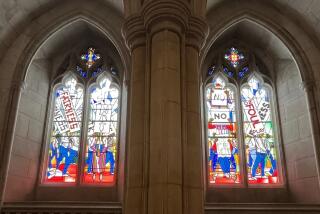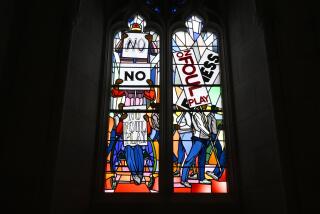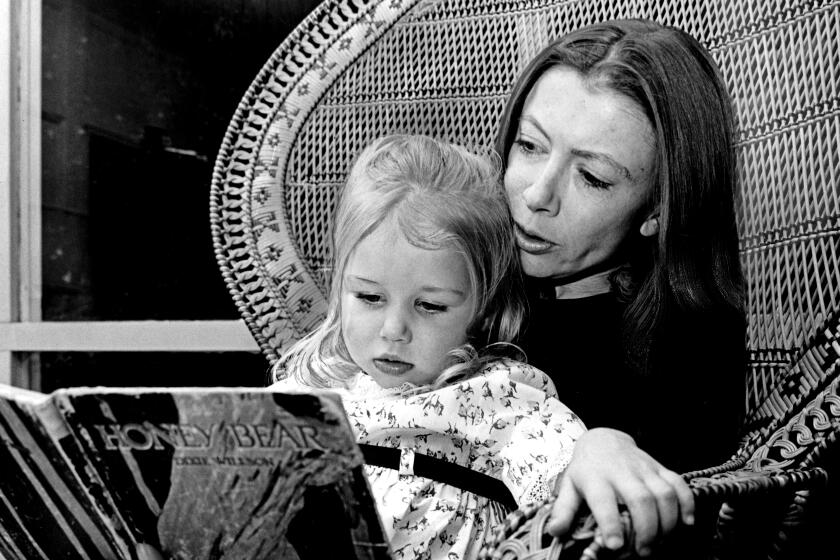Shanghai’s Red Church rises once again
- Share via
Reporting from Shanghai — During the winter of 1941 everyone in Shanghai was showing war films.... To Jim’s dismay, even the Dean of Shanghai Cathedral had equipped himself with an antique projector.
— “Empire of the Sun”
“Empire of the Sun,” J.G. Ballard’s atmospheric novel about his coming of age in China, opens on the eve of Pearl Harbor. Shanghai Cathedral choir boys are being marched to the crypt to watch newsreels of Royal Air Force fighter planes falling in flames to the English countryside.
The cathedral’s actual name was Holy Trinity, and Ballard, the son of expatriate Britons, attended the cathedral’s prestigious boys school.
Built in a Victorian Gothic style in the 1860s, Holy Trinity served for nearly eight decades as the spiritual home for colonialists who flocked to Shanghai after Britain’s victory in the Opium Wars opened the port to trade. With its stout pews, stained-glass windows and 2,500-pipe organ, the red-brick Anglican church provided a cloistered haven in an exotic, untamed place.
Along with the men-only Shanghai Club and racehorse owners’ Shanghai Race Club, “the cathedral was a central feature of British life in a faraway land,” said Peter Hibbard, a British expat and president of the Royal Asiatic Society China in Shanghai. Here in the Red Church, as many called it, babies were baptized, couples were married and parishioners were laid to rest in a homey refuge complete with manicured lawn, gargoyles and spire.
Now, after decades in the control of local politicians, during which it was revamped as a theater and meeting hall and later left to deteriorate, the cathedral is nearing the end of a painstaking renovation by a Chinese Protestant organization. Later this year, this historic church will reopen to what is expected to be a crush of worshipers once dozens of faux stained-glass plastic windows have been replaced with the real thing.
Under the Red Church’s watch, this tumultuous city has come full circle — from anything-goes capitalism to the birth of communism to war with Japan to the religion-crushing Cultural Revolution to, once again, unfettered commercialism and even a robust revival of Christianity.
Church revival
Jonathan Yardley’s jaw dropped when he entered Holy Trinity in February 2005. “What the hell have they done?” the conservation architect recalls wondering.
Instead of immaculate tile and marble, Yardley found a sloping ground floor made of 7 inches of reinforced concrete and a “floating” second floor above the building’s interior arches. Turquoise fans and modern chandeliers hung from the superimposed ceiling. Red-brick walls had been plastered over and painted. The altar had been turned into a stage, and hundreds of raked theater seats had been squeezed in where parishioners in sturdy wooden pews had once recited the Lord’s Prayer.
Yardley was a consultant with Commonwealth Historic Resource Management, a firm in Vancouver, Canada, that had been hired to study the cathedral’s history and devise a conservation plan. He saw immediately that many bricks would have to be replaced. Interior alterations would have to be carefully dismantled to restore the church to its appearance in 1930, considered its spiritual and physical peak.
The renovation would be done under the auspices of the Three-Self Patriotic Movement. Founded in the 1950s, the Christian organization promoted a strategy of “self-governance, self-support and self-propagation” to assure that members would be free of foreign missionaries’ influence. The wish to renovate reflected the growing interest in preserving Shanghai’s historic Western architecture, long denigrated as evidence of Chinese subordination to imperialism.
“Many people think the architectural style of this church is very unique and beautiful,” said Rev. Gao Feng, president of the Shanghai-based China Christian Council, an umbrella organization for Three-Self and other government-approved Protestant Christian churches in China. “We think it’s important to restore it for neighboring communities to worship.”
The council, which has offices in the former cathedral school, estimates there are 23 million Christians in China, but many China watchers believe the number could be double or triple that.
“There is quite a significant religious revival in China,” said Richard Madsen, a sociology professor at UC San Diego with expertise in Chinese culture. The government still attempts to restrict religious practice to registered places of worship, Madsen added, but untold numbers of Chinese practice on their own in non-approved “house churches.”
Far from a “house church,” Holy Trinity represented the height of formal Christian religion in a city that had never seen its like.
A church rises
In 1847, Shanghai was a rambunctious place where opium smuggling, prostitution and gangsters all flourished. To counter the corruption, an English businessman donated land and money to build a small church in the international settlement controlled by Britain and the United States.
The site was three blocks west of the Bund, the mile-long river embankment now lined with banks and posh hotels in magnificently restored Western-style buildings. A church was soon erected, but three years later the roof fell in.
In 1863, church trustees commissioned George Gilbert Scott to draw plans for “a model of modern ecclesiastical architecture” for 800 worshipers at the considerable cost of 60,000 taels, a part of the Chinese system of weights and currency at the time. The devout son of a clergyman, Scott “was the architectural superstar of England,” said Harold D. Kalman, a principal with Commonwealth Historic Resource Management. (Kalman, heritage consultant on the Holy Trinity renovation, researched the cathedral’s history and produced the conservation plan.)
Scott spearheaded England’s Gothic revival, creating many well-loved structures, including the Midland Grand Hotel at St. Pancras station and the Albert Memorial. From his London office, Scott designed the Shanghai church in the cruciform, or cross-shaped, style prevalent in the early 13th century. Scott envisioned exuberant accents, including hand-carved woodwork and rows of dark blue or black bricks to represent what the British called engineering brick.
The building featured a nave, transept, north and south aisles, a chancel and two small chapels, with lancet and rose windows, hexagonal and round columns, and arches both Romanesque (rounded) and Gothic (pointed). The Jan. 20, 1866, North-China Herald and Market Report described the planned church as “massive and substantial in its feature.”
Yet Scott “let them down terribly,” Kalman said, by proposing a building that was far costlier and had far fewer seats than specified.
It fell to William Kidner, a British architect working in Shanghai, to modify the drawings. Kidner lengthened and widened the building and dispensed with the clerestory so that walls could be thinner. He substituted a wooden roof for a vaulted brick roof. Scott approved the changes, and in May 1866 members of masonic lodges staged a procession and ceremony to lay the foundation stone as crowds of Chinese lined the streets to watch.
By the end of 1867, walls had been raised to 15 feet, and the granite shafts of the nave and aisle arcades, chapels and apse had been set in place. The roof timbers had been framed. Fittings from England had arrived, stained glass had been ordered and bricks had been locally manufactured.
Holy Trinity Church officially opened Aug. 1, 1869. In 1876, it became the cathedral of the Diocese of North China.
In 1925, two organ builders from Harrison & Harrison Ltd. in Durham, England, sailed to Shanghai to install a three-manual instrument with more than 2,500 pipes. It filled two stories near the chancel to the right of the “crossing,” the junction of the church’s four arms.
“Every bit of the organ was brought from the docks, nearly two miles, on hand carts by coolies,” the brothers Doyley and Austin Jones wrote in a letter to their employer, preserved in the company’s archives. But the laborers soon went on strike after Shanghai Municipal Police officers opened fire on Chinese protesters in the international settlement. (Four years earlier, Mao Tse-tung and colleagues had launched the Communist Party in Shanghai, and this “May 30th Movement” provided a boost.)
In the end, the Jones brothers and a Russian helper assembled the organ. Austin Jones professed himself just as happy, given the Chinese workers’ tendency to walk off with supplies. “We had to have a special place built to prevent them stealing the pipes, but the number of brass screws that have disappeared is wonderful,” Austin wrote to his bosses.
In 1928, the four-story school that Ballard would later attend was added.
By about 1930, Shanghai and the cathedral had reached their zeniths, but the glory days were numbered. In 1937, the Japanese Imperial Army invaded the city and surrounded the international settlement. After the bombing of Pearl Harbor, the Japanese occupied the settlement, evicting residents from their homes and effectively ending Anglo-American influence.
Greg Leck, author of the 2006 book “Captives of Empire,” said some expats briefly lived under the cathedral’s blue-painted wooden beams, which were adorned with gold-leaf flowers and stars. The Japanese soon moved these expats and the Allied population at large into squalid internment camps, as Ballard relates in “Empire of the Sun.”
From then on, Holy Trinity went largely unmaintained.
Reclamation
By the early 1950s the church could not afford to pay taxes, and the fledgling Three-Self Patriotic Movement (and, by extension, the Chinese government) took control.
When the decade-long Cultural Revolution began in 1966, public worship was banned. Many pagodas, temples and churches were destroyed or converted for secular use. Communist Red Guards dismantled Holy Trinity’s spire, and local bureaucrats set up offices in the bell tower. At some point, the cathedral was stripped of its pews, stained-glass windows and organ.
Preservation advocates celebrated in 1989 when the structure was designated as a cultural heritage site. In 2005, the Chinese government transferred ownership of Holy Trinity to the Three-Self Patriotic Movement. With funds from the Chinese government’s “religion bureau,” the organization hired consultants and 3 1/2 years ago began the renovation.
A furniture factory in Zhejiang province produced scores of carved teak pews, according to Hou Jin, interior architect with Shanghai Xian Dai Architectural Design Group, whose East China Architectural Design & Research Institute Co. was the project’s chief consultant. Brick by brick, workers rebuilt the spire, which once again towers over the neighborhood that now nearly engulfs the church.
Not all interior elements were redone to original specs. Unornamented wood stands in for what had been an elaborately carved memorial to World War I British war dead. A small electric organ, with a few pipes for show, will serve in place of the mammoth Harrison & Harrison model, which would have cost about $2.6 million to reproduce. Woodworkers who re-created the elaborately carved baptismal area added a round-cheeked cherub with Chinese features.
To date, the renovation has cost about $3 million, a pittance by U.S. standards. The Three-Self Patriotic Movement is attempting to raise nearly $800,000 more to buy and install dozens of stained-glass windows, the final step, Hou said. After that, the Red Church will welcome worshipers.
A theologian who saw the cathedral as the renovation was underway said the project speaks to the dramatic changes occurring within China.
“While there are many flourishing churches in China, this cathedral has a special significance,” Richard Mouw, president of Fuller Theological Seminary in Pasadena, said in an e-mail. “The very fact that it is reopening … is yet another manifestation of the marvelous resurgence of faith in China.”
More to Read
The biggest entertainment stories
Get our big stories about Hollywood, film, television, music, arts, culture and more right in your inbox as soon as they publish.
You may occasionally receive promotional content from the Los Angeles Times.











